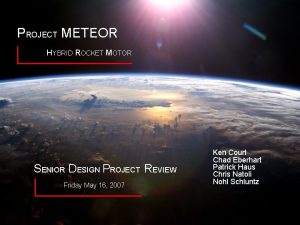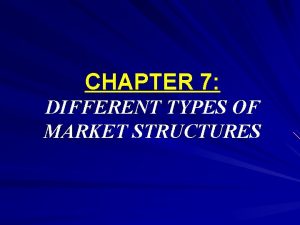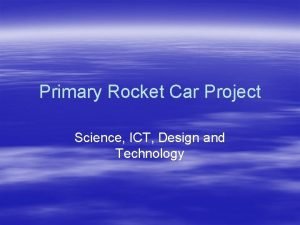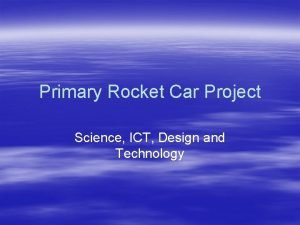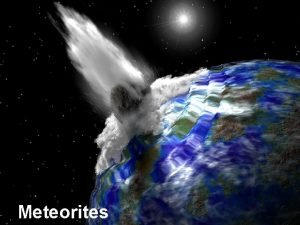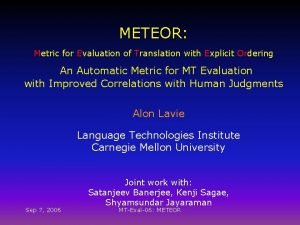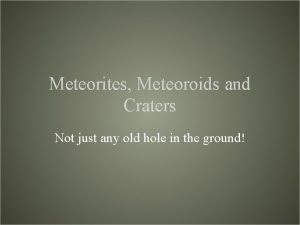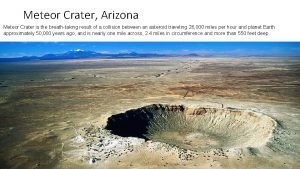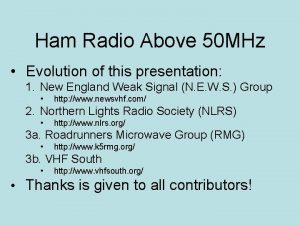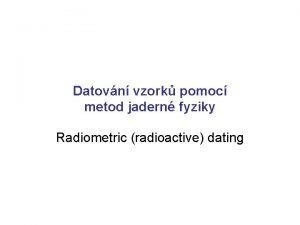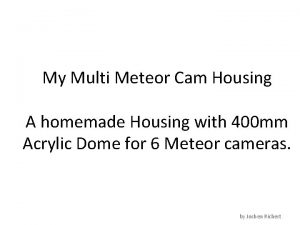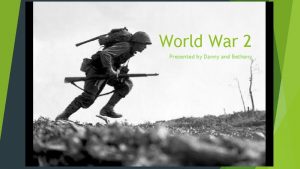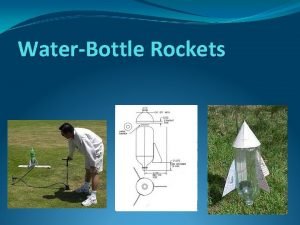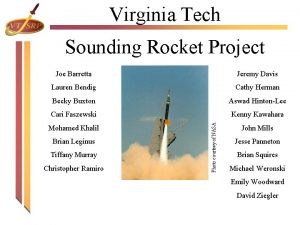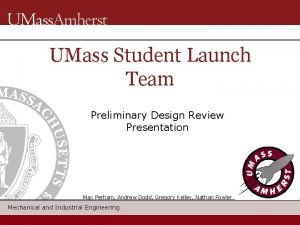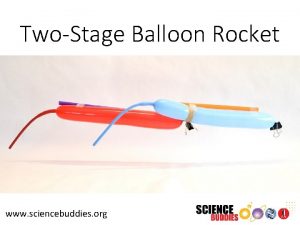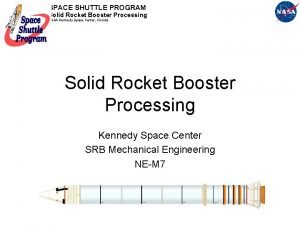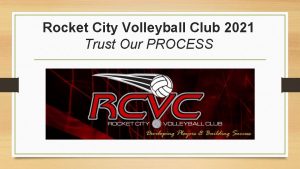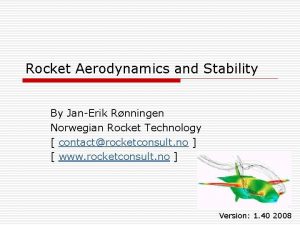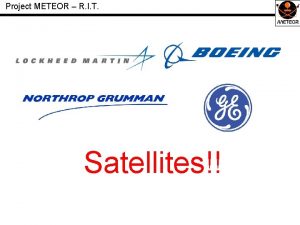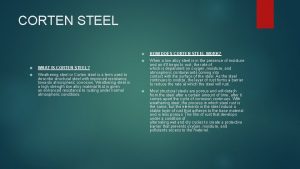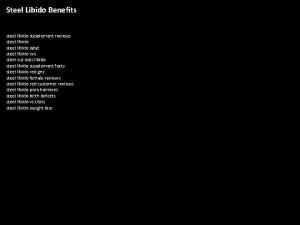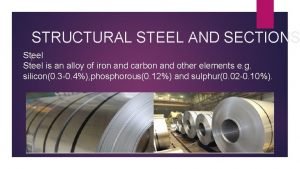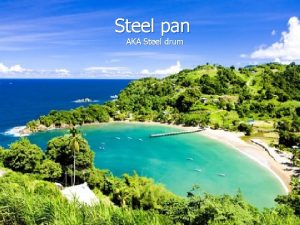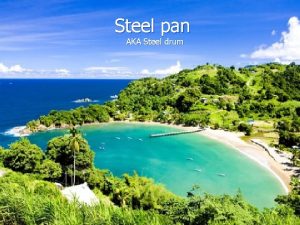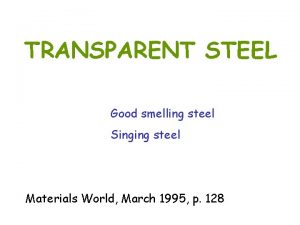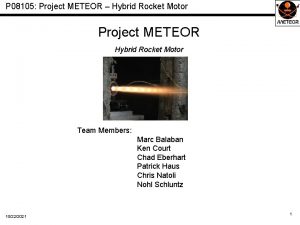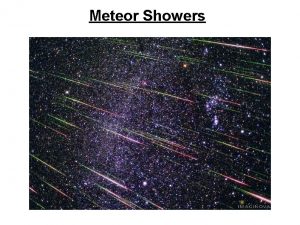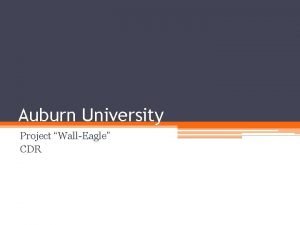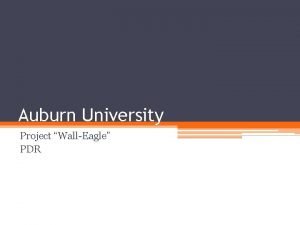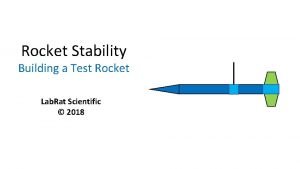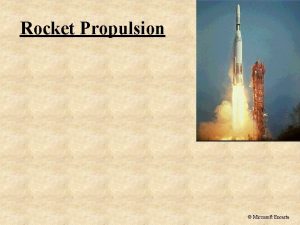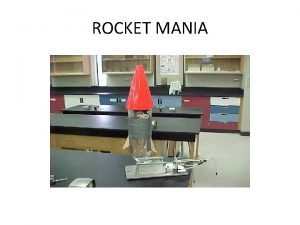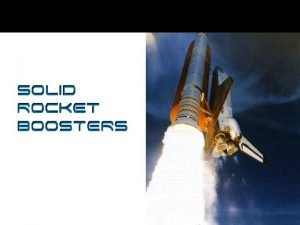P 07105 Project METEOR Steel Rocket Project METEOR























- Slides: 23

P 07105: Project METEOR - Steel Rocket Project METEOR Design and Optimization of a Small Scale Rocket for Pico. Satellite Launching Team Members: Ray Mulato Joe D’Amato Joel Baillargeon Kent Etienne Guion Lucas Ryan Kuhns January 19, 2007 1

P 07105: Project METEOR - Steel Rocket Project Overview Projected Flight Pattern January 19, 2007 2

P 07105: Project METEOR - Steel Rocket Project Overview Hybrid Rocket • Classified as utilizing a liquid oxidizer and solid propellant to achieve thrust – Current Oxidizer: Nitrous Oxide (NOX) – Current Propellant: Hydroxyl Terminated Poly-Butadiene (HTPB) – Possible Propellant: Poly-Methyl Methacrylate (PMMA ) January 19, 2007 3

P 07105: Project METEOR - Steel Rocket Current Test Chamber Setup Hydroxyl-Terminated Polybutadiene (HTPB) Fuel Grain Chamber Wall Snap Ring Injector Plate Garolite Pre & Post Combustion Chambers January 19, 2007 2 -D Nozzle 4

P 07105: Project METEOR - Steel Rocket Project Deliverable – Specific Impulse • Theoretical Isp for HTPB & NOX 320 s • Properties – Efficiency of propulsion system – Ratio of thrust to weight – Change in momentum per unit mass of propellant – Affected by combustion temp, chamber pressure, exit pressure, and mass flow rate January 19, 2007 5

P 07105: Project METEOR - Steel Rocket Project Objectives • Optimization of: – Nozzle Geometry – Fuel Grain • Material • Geometry – Oxidizer Flow Rate – Ignition System Specific Impulse of 220 s • Data Acquisition – Temperature – Pressure – Thrust January 19, 2007 6

P 07105: Project METEOR - Steel Rocket Project Specifications From Guidance Team for controlled flight to 90 km: mfuel = 10 kg; mdot = 0. 2 kg/s; tburn = 50 s; T = 445 N (100 lb) Specification Number January 19, 2007 Design Specification Unit of Measure Marginal Value Ideal Value sec 227 300 1 Specific Impulse 2 Oxidizer/Fuel Ratio - 5 8 3 Thrust N 445 500 4 Burn Time sec 50 60 5 Overall Mass Flow Rate kg/s 0. 2 0. 17 6 Mass of Fuel Grain kg 1. 6 1. 1 7 Mass of Oxidizer kg 8 8. 75 7

P 07105: Project METEOR - Steel Rocket Testing Purpose • Testing took place December 9 th & 10 th, 2006 • Vary Nozzle Geometry to see the effects on thrust • Conceivably measure mass flow rate of system – Weigh nitrous oxide tank and fuel grains prior and after each test – Come up with approximate O/F ratios • Introduce Team to current design January 19, 2007 8

P 07105: Project METEOR - Steel Rocket Results January 19, 2007 9

P 07105: Project METEOR - Steel Rocket Testing 11 Degree Half Angle January 19, 2007 10

P 07105: Project METEOR - Steel Rocket Testing 11 Degree Half Angle January 19, 2007 11

P 07105: Project METEOR - Steel Rocket September 16 th, 2006 Test January 19, 2007 12

P 07105: Project METEOR - Steel Rocket First Testing – December 2006 • Observations – – – – – January 19, 2007 Overall system setup Ignition system can be inconsistent in terms of time Oxidizer tank temperature varied considerably from test to test Teflon tape in feed system was tedious and led to increased time between tests Brass fittings can be cross-threaded and/or broken easily Noticeable inaccuracies in current mass flow rate measurement Power supply was convoluted 8 Degree Half Angle Nozzle design gave the best thrust results Nitrogen tank regulator was damaged, consistently leaks, had to develop a work around for it • Conclusions – – – – – Began to reduce time between tests Steady voltage and current supply is needed to minimize ignition time A method of controlling internal tank temperature is needed to remove guesswork Stainless steel can be used in place of brass and teflon combination Stainless steel fittings in oxidizer feed system should be used Means of gathering reliable mass flow is crucial – Coriolis flow meter or volumetric flow meter in combination with other values A generator might be a better means of running the operation Difficult to draw definite conclusion from this, as multiple variables play a role in thrust Need to order a more robust regulator 13

P 07105: Project METEOR - Steel Rocket Feed System Equipment • Goals of adding additional feed system equipment: – Acquire a reliable value for mass flowrate in order to calculate a number of parameters • Regression rate • Test Chamber Pressure • Oxidizer-Fuel Ratio • Oxidizer Mass Velocity – Feedback Pressure Regulator • Constant supply pressure leads to overall experimental control • Capability to vary supply pressure – Optimization of nozzle for a supply pressure – Gas Tank Heating Blanket • Allows for a controlled internal tank temperature – Temperature control leads to internal pressure control January 19, 2007 14

P 07105: Project METEOR - Steel Rocket Possible Test Chamber Improvements • Longer, wider chamber for longer burn and increased thrust • Injector plate – redesign hole pattern and sizing in order to increase burn efficiency and completeness • Use of Polymethyl Methylacrylate (PMMA) as a solid fuel in place of HTPB – possibly higher thrust • Redesign of Pre and Post combustion chambers to minimize viscous losses inside the chamber • Redesign of nozzle to take advantage of expansion of hot gas inside the diverging section of the nozzle rather than behind it • Redesign of fuel grain to optimize regression rate and thrust (increase surface area exposed to flame) January 19, 2007 15

P 07105: Project METEOR - Steel Rocket Current Feed System January 19, 2007 16

P 07105: Project METEOR - Steel Rocket Possible Feed System Improvements • Control of Oxidizer (N 2 O) Pressure via tank as well as before injector – installation of a feedback regulator • Use of Stainless Steel in place of Brass in Nitrous Oxide feed system due to N 2 O effect on brass components (shorter life, corrosion of surfaces) • Use of a tank “stand” to hold oxidizer tank inverted as well as to measure weights (for the current round of testing) January 19, 2007 17

P 07105: Project METEOR - Steel Rocket Proposed Changes to Feed System Highlighted areas show where changes are being made January 19, 2007 18

P 07105: Project METEOR - Steel Rocket Feed System Equipment Pressure Transducer Mass Flowrate Meter Tee Fitting Backflow Pressure Regulator Inline Flow Filter Test Chamber January 19, 2007 19

P 07105: Project METEOR - Steel Rocket Design of Experiments High 4 O. V. A. T. 1 Low 2 Factor B 6 Factor B 5 High 3 Factor A 4 High Low 3 Factorial 1 2 Factor A High • Factorial Method vs. One Variable at a Time – Factorial method able to achieve comparable results with fewer tests – Factorial method able to correlate relationships between factors being tested January 19, 2007 20

P 07105: Project METEOR - Steel Rocket Design of Experiments Independent Test Variables Levels • • • NOX Pressure (Pre-Inj. ) Length of Fuel Grain Post-Combustion Chamber Nozzle Injector Plate Fuel Grain Additive • • Fuel Grain Geometery • January 19, 2007 3 levels (∆ of 50 psi. ) 2 levels (11” – 18”) 4 levels (1. 5” - 3. 0”; ∆ 0. 5”) 2 levels (4 holes/ 9 holes) 2 levels (Alum. Pwdr/ Non-Alum. Pwdr) 3 levels (Star, Circle, Cross) 21

P 07105: Project METEOR - Steel Rocket Design of Experiments Variables In Next Test • NOX Pressure (Pre-Inj. ) • Length of Fuel Grain • Injector Plate • Levels • 3 levels (∆ of 50 psi. ) • 2 levels (11” – 18”) • 2 levels (4 holes/ 9 holes) Reasons for choosing these variables: – Short lead time for testing – See how pressure, and (L/D) ratio of the fuel grain effects thrust – No prior knowledge of injector plate design – Combustion chamber wasn’t chosen due to the additional changes to the system needed to accommodate that test. January 19, 2007 22

P 07105: Project METEOR - Steel Rocket Senior Design I Project Plan January 19, 2007 23
 Meteor rocket motor
Meteor rocket motor Monopoly business examples
Monopoly business examples Rocket car project
Rocket car project Rocket car project
Rocket car project Inside of meteorite
Inside of meteorite Sky scandr
Sky scandr Gambar komet dan meteor
Gambar komet dan meteor Meteor metric
Meteor metric Meteor crater, arizona
Meteor crater, arizona Beaverhead crater
Beaverhead crater Meteor scatter 144 mhz
Meteor scatter 144 mhz Jadern
Jadern Meteor pcn com
Meteor pcn com A ship-mounted aerial mine rocket launcher
A ship-mounted aerial mine rocket launcher Aerodynamics of a water bottle rocket
Aerodynamics of a water bottle rocket Jeremy rocket
Jeremy rocket Umass rocket team
Umass rocket team How to make a two stage balloon rocket
How to make a two stage balloon rocket Far side rocket scientist
Far side rocket scientist Solid rocket booster
Solid rocket booster Rocket inventor
Rocket inventor Mass velocity
Mass velocity Rocket city volleyball club
Rocket city volleyball club Aerodynamics of rockets
Aerodynamics of rockets
